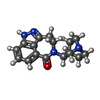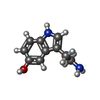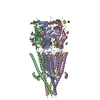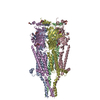+Search query
-Structure paper
| Title | Structural basis for partial agonism in 5-HT receptors. |
|---|---|
| Journal, issue, pages | Nat Struct Mol Biol, Vol. 31, Issue 4, Page 598-609, Year 2024 |
| Publish date | Jan 4, 2024 |
 Authors Authors | Kevin Felt / Madeleine Stauffer / Leslie Salas-Estrada / Peter R Guzzo / Dejian Xie / Jinkun Huang / Marta Filizola / Sudha Chakrapani /   |
| PubMed Abstract | Hyperactivity of serotonin 3 receptors (5-HTR) underlies pathologies associated with irritable bowel syndrome and chemotherapy-induced nausea and vomiting. Setrons, a class of high-affinity ...Hyperactivity of serotonin 3 receptors (5-HTR) underlies pathologies associated with irritable bowel syndrome and chemotherapy-induced nausea and vomiting. Setrons, a class of high-affinity competitive antagonists, are used in the treatment of these conditions. Although generally effective for chemotherapy-induced nausea and vomiting, the use of setrons for treating irritable bowel syndrome has been impaired by adverse side effects. Partial agonists are now being considered as an alternative strategy, with potentially less severe side effects than full antagonists. However, a structural understanding of how these ligands work is lacking. Here, we present high-resolution cryogenic electron microscopy structures of the mouse 5-HTR in complex with partial agonists (SMP-100 and ALB-148471) captured in pre-activated and open-like conformational states. Molecular dynamics simulations were used to assess the stability of drug-binding poses and interactions with the receptor over time. Together, these studies reveal mechanisms for the functional differences between orthosteric partial agonists, full agonists and antagonists of the 5-HTR. |
 External links External links |  Nat Struct Mol Biol / Nat Struct Mol Biol /  PubMed:38177669 PubMed:38177669 |
| Methods | EM (single particle) |
| Resolution | 2.7 - 3.79 Å |
| Structure data | EMDB-29409, PDB-8frw: EMDB-29410, PDB-8frx: EMDB-29411, PDB-8frz: EMDB-29418, PDB-8fsb: EMDB-29421, PDB-8fsp: EMDB-29422, PDB-8fsz: |
| Chemicals |  ChemComp-NAG:  ChemComp-Y7H:  ChemComp-HOH:  ChemComp-Y82:  ChemComp-SRO: |
| Source |
|
 Keywords Keywords | TRANSPORT PROTEIN / Partial agonist / cys-loop / pLGIC / ion channel / agonist |
 Movie
Movie Controller
Controller Structure viewers
Structure viewers About Yorodumi Papers
About Yorodumi Papers
















